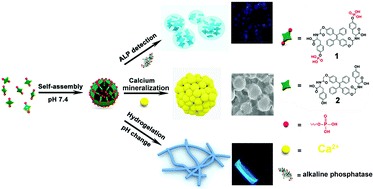Incorporation of tyrosine phosphate into tetraphenylethylene affords an amphiphilic molecule for alkaline phosphatase detection, hydrogelation and calcium mineralization
Jiangsu Key Laboratory of Advanced Functional Polymer Design and Application, College of Chemistry, Chemical Engineering and Materials Science, Soochow University, Suzhou, China
J. Mater. Chem. B 2013, 1, 5550-5556
Simple conjugation of tyrosine-phosphate with tetraphenylethylene generates a new amphiphile, which not only undergoes enzymatic dephosphorylation to generate a relative hydrophobic residue for alkaline phosphatase (ALP) detection with significant enhancement of the fluorescence signals, but also self-assembles in water to result in a novel supramolecular hydrogel with gelation-enhanced fluorescence emission features upon the changes of pH. In addition, the highly ordered micelle nanostructures self-assembled from this amphiphile exhibit the ability to serve as efficient templates to promote the nucleation and growth of calcium phosphate. Since amino acids and peptides are an important class of bioactive entities whose functions range from biomolecular recognition to supramolecular self-assembly, this study demonstrates the potential to generate an amphiphile with a novel molecular architecture from the TPE and amino acid conjugate with multifunctional properties.
链接: //pubs.rsc.org/en/content/articlelanding/2013/tb/c3tb21024c#!divAbstract
a